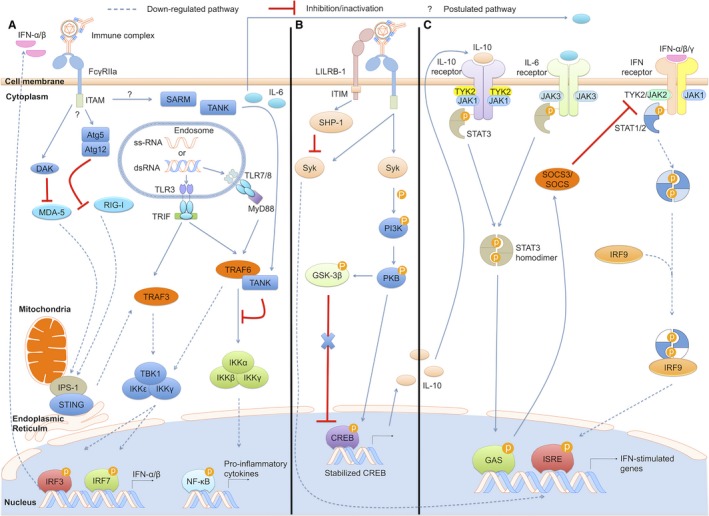Figure 2.

Dengue virus subversion of host innate immune responses during ADE can occur via three pathways. (A) Infectious DENV‐sub‐neutralizing antibody complexes internalized via phagocytic FcγRIIa pathway is uncoated within the endosome, where viral RNA is recognized by TLR. FcγR synergize with TLR to orchestrate the induction of cytokines: promoting DAK (dihydroxy acetone kinase), Atg5/12 (autophagy‐related 5/12 protein), SARM (Sterile‐alpha and Armadillo motif‐containing protein), and TANK (TRAF family member‐associated nuclear factor kappa‐B activator), down‐regulating RIG‐I and MDA5 expression, sabotaging the TLR‐independent antiviral pathway, subsequently suppressing production of type I IFNs. (B) Co‐ligation of FcγR and LILRB1 (leukocyte immunoglobulin‐like receptor‐B1) to DENV‐immune complexes and the DENV virion, respectively, inhibits the activation of Syk and abrogate the expression of ISGs. (C) Ligation of FcγR to immune complexes also induces upregulation of IL‐10 via Syk (spleen tyrosine kinase‐mediated PI3K/PKB (phosphoinositide 3 kinase) activation. The activation of IL‐10 as well as IL‐6 triggers SOCS (suppressor of cytokine signaling) pathway, inhibiting the JAK/STAT signaling pathway, decreasing pro‐inflammatory cytokine production. ITIM, immunoreceptor tyrosine‐based inhibitory motif; ITAM, immunoreceptor tyrosine‐based activation motif; SHP‐1, Src homology 2‐containing protein tyrosine phosphatase‐1; PKB, protein kinase B; GSK‐3β, glycogen synthase kinase; CREB, cyclic adenosine monophosphate response element‐binding; Tyk, tyrosine kinase.
